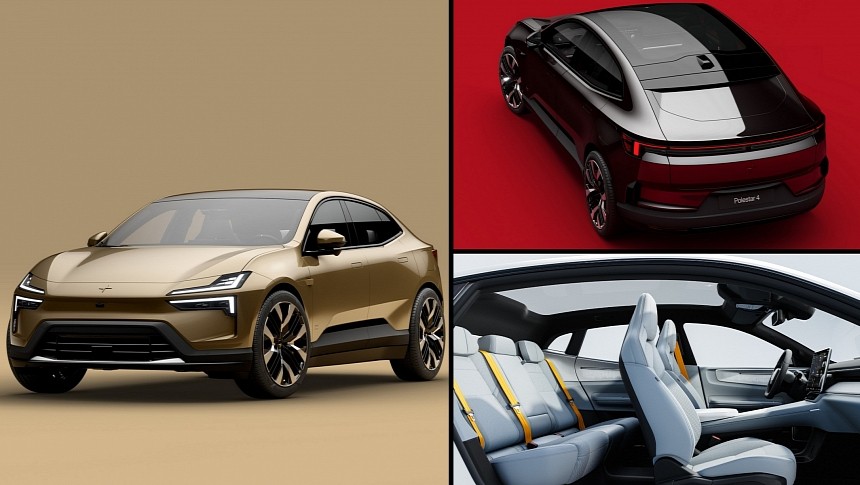Polestar has decided to attract attention toward its electric coupe-SUV by labeling it as "a new breed," but the truth is that sloping crossovers are nothing new. And its nameplate is a bit confusing, too, if you are unfamiliar with the company's naming scheme.
The Swedish-Chinese automotive brand has not been independent for long, so freshman mistakes may be understandable, of course. It was established in 1996 as an offshoot of Flash/Polestar Racing, which was Volvo Cars' partner in making track and street goodies. Now the racing team is called Cyan Racing, and it still keeps a close relationship with the automaker after the latter acquired Polestar in 2015 and allowed it to go public on the Nasdaq exchange last summer.
Trying to make itself as easy to remember among the cobweb of automotive industry intrigue, Polestar's models were named as efficiently as possible since the start – Polestar 1 for the initial plug-in hybrid grand tourer that is already discontinued, Polestar 2 for the compact executive liftback that seeks to compete with Tesla's Model 3 since 2020, and Polestar 3 for the mid-size luxury electric crossover SUV that was introduced earlier this year as a threat to the Mercedes EQE SUV and Tesla Model Y, among others.
But now there is also a fresh Polestar 4, which is next in line for release – starting with China after production begins in November in Hangzhou Bay, then followed by North America sometime next year from around $60k. However, there is a catch – anyone thinking that the new Polestar 4 is bigger than the Polestar 2 or 3 would be mistaken. Instead, the latest release actually slots between them, as we are dealing with a compact luxury electric crossover of the coupe-SUV variety.
Now that we have cleared that quirk, the performance electric coupe-SUV will seek to mesmerize potential customers with a design inspired by the Polestar Precept concept car. The most striking feature is the elimination of the rear window, for sure. Otherwise, it is a 'standard' coupe-SUV affair, and one riding on top of parent Geely's premium Sustainable Experience Architecture (SEA) with a 2,999 mm wheelbase (118 inches). The other dimensions are 4,839 mm, 2,139 mm, and 1,544 mm – 190.5, 81.21, and 60.78 inches in length, width, and height, respectively.
The massive full-length glass roof is another distinguishing feature of the cockpit, which also includes a novel sustainability-driven approach regarding interior materials. It features a tailored knit textile inspired by the Precept, consisting of 100 percent recycled PET and bio-attributed MicroTech vinyl and animal welfare-secured Nappa leather upholsteries. There are also recycled PET inlay carpets, ECONYL (reclaimed fishing nets) floor carpets, and specific door panels made from NFPP (natural fiber polypropylene).
Moving on to the performance chapter, we are dealing here with Polestar's "fastest production car to date," hitting 60 mph (96 kph) in less than 3.8 seconds thanks to a flagship 400 kW (544 ps/536 hp) and 686 Nm (506 lb-ft) powertrain. Both single and dual-motor versions will become available, starting with a long-range rear single motor packing 200 kW (272 ps/268 hp) and a "preliminary range target of over 300 miles EPA," which is around 483 km. The battery pack has 102 kWh for both models, and 22 kW AC plus up to 200 kW DC charging is a standard feature for all variants, as is the vehicle-to-load (V2L) capability.
Trying to make itself as easy to remember among the cobweb of automotive industry intrigue, Polestar's models were named as efficiently as possible since the start – Polestar 1 for the initial plug-in hybrid grand tourer that is already discontinued, Polestar 2 for the compact executive liftback that seeks to compete with Tesla's Model 3 since 2020, and Polestar 3 for the mid-size luxury electric crossover SUV that was introduced earlier this year as a threat to the Mercedes EQE SUV and Tesla Model Y, among others.
But now there is also a fresh Polestar 4, which is next in line for release – starting with China after production begins in November in Hangzhou Bay, then followed by North America sometime next year from around $60k. However, there is a catch – anyone thinking that the new Polestar 4 is bigger than the Polestar 2 or 3 would be mistaken. Instead, the latest release actually slots between them, as we are dealing with a compact luxury electric crossover of the coupe-SUV variety.
Now that we have cleared that quirk, the performance electric coupe-SUV will seek to mesmerize potential customers with a design inspired by the Polestar Precept concept car. The most striking feature is the elimination of the rear window, for sure. Otherwise, it is a 'standard' coupe-SUV affair, and one riding on top of parent Geely's premium Sustainable Experience Architecture (SEA) with a 2,999 mm wheelbase (118 inches). The other dimensions are 4,839 mm, 2,139 mm, and 1,544 mm – 190.5, 81.21, and 60.78 inches in length, width, and height, respectively.
The massive full-length glass roof is another distinguishing feature of the cockpit, which also includes a novel sustainability-driven approach regarding interior materials. It features a tailored knit textile inspired by the Precept, consisting of 100 percent recycled PET and bio-attributed MicroTech vinyl and animal welfare-secured Nappa leather upholsteries. There are also recycled PET inlay carpets, ECONYL (reclaimed fishing nets) floor carpets, and specific door panels made from NFPP (natural fiber polypropylene).
Moving on to the performance chapter, we are dealing here with Polestar's "fastest production car to date," hitting 60 mph (96 kph) in less than 3.8 seconds thanks to a flagship 400 kW (544 ps/536 hp) and 686 Nm (506 lb-ft) powertrain. Both single and dual-motor versions will become available, starting with a long-range rear single motor packing 200 kW (272 ps/268 hp) and a "preliminary range target of over 300 miles EPA," which is around 483 km. The battery pack has 102 kWh for both models, and 22 kW AC plus up to 200 kW DC charging is a standard feature for all variants, as is the vehicle-to-load (V2L) capability.





























